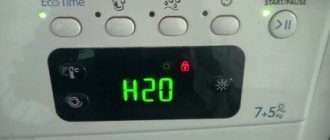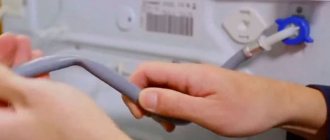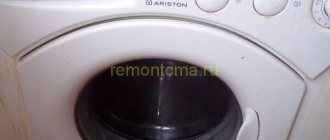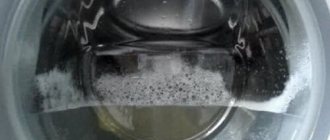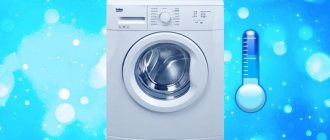Accustomed to the benefits of civilization, we don’t even notice what household appliances do for us: we automatically cook food, clean the apartment, or wash clothes. The slightest malfunction in the operation of an appliance, especially a washing machine, can take us by surprise. What to do if the “washing” unit does not draw water properly and hums all the time? Read about common causes of malfunctions in this material and watch a detailed video of methods for resolving the problem.
Incorrect device connection
This malfunction often occurs when installing recently purchased washing equipment yourself.
There may be several reasons why water does not enter the drum:
- the drain is not connected correctly to the unit or drain;
- the water supply hose is pinched;
- installation or operation rules have been violated.
Connecting a washing machine
If the washing machine has a display, then an error code may appear on its screen, which will help you find out the cause of the malfunction. As a rule, all of them are described in the manual for the machine. If the drain hose leaks water at the connection to the unit or at the outlet to the sewer, check that it is installed tightly and that there are no kinks.
Attention! Failure to properly lift the drain hose to the correct height is a common cause of machine malfunction.
Also, water does not flow into the machine if the supply hose is pinched or deformed. Check it for any sharp bends or breaks that are preventing good flow and turn the unit back on.
Weight gain norms
In what situations should you raise the alarm? How much weight should a child gain? Now you can find a variety of tables with standards for girls and boys. There are even special calculators - they will show how much your baby should gain per month and ultimately weigh. The main advantage of such utilities is that they take into account the baby’s growth and initial data.
However, there are certain norms for weight gain. The main breakthrough should be observed in the first months of the baby’s life. So, in 30 days over the course of six months, a child gains 800-900 grams, and then up to a year - 400. Sometimes more, sometimes less. Small errors are acceptable. But severe deviations usually cause panic and fears for parents.
The water supply tap is closed or there is low pressure in the water supply
New type washing machines must have a water shut-off tap. As a rule, its valve is located directly on the pipe or on the comb. It is clear that if the tap is closed, water will not flow into the car. At the same time, the unit hums, and an error is displayed on the display.
It is quite easy to fix such a “breakdown”, just press the pause button, open the valve and start the machine again.
If the tap is open, but water does not flow into the washing machine or it fills slowly, then there may be a problem in the water supply: there is no water or the pressure in the pipes is not strong enough. Open any tap in the bathroom and check for availability. Call the hotline of your housing office and find out the timing of water supply. Of course, you will have to postpone washing for this time.
Attention! Do not turn on the washing machine immediately when water appears in the water supply. Due to wear and tear of the water pipes, it may become rusty.
Factors affecting washing time
The operating time of the machine depends on the set modes; it is lengthened by additional functions, reduced by low temperatures and by skipping some actions.
Water heating temperature
Water is drawn from a cold tap and heated automatically. The higher the temperature, the longer the device operates. It takes 10-15 minutes to heat up to 95°; the duration of operation, accordingly, increases depending on the assigned temperature.
Extra rinse
A new set of water for repeated rinsing, as well as the work itself, increases the cycle by 15-25 minutes.
Spin speed
Getting laundry semi-dry requires high spin speeds. At low speeds you can dry things in 10 minutes, at high speeds it will take 15 minutes.
Extra wash function
Up to a quarter of an hour is added for additional washing, during which time the drum rotates, consuming electricity.
Soak
Pre-soaking extends the wash by 15-30 minutes, depending on the machine model.
Boiling function
When boiling is scheduled, additional electricity consumption occurs to heat the water, which increases the time by 5-10 minutes.
Laundry weight
Determining the weight of laundry is available only in expensive models of washing machines of the latest generations. Performing an additional function extends the operation of the device.
Degree of pollution
Only highly intelligent, expensive machine models can determine how dirty the laundry is. The wash is extended by the processor's operating time and additional time for washing.
Individual features of the model
Modern models of washing machines, in general, work faster. Water heating is accelerated, drainage occurs more dynamically, and transition to another operation occurs. Old machines can complete the minimum amount of work in 40 minutes, modern machines can be completed in 15-30 minutes.
Clogged or broken inlet valve filter
Everything is in order with the water supply in the house, the device is working and connected correctly, but water still does not flow into the machine, and the process is accompanied by a characteristic hum? The reason may be more serious - the water supply valve is clogged or completely broken.
Water enters the washing device under pressure from the water supply. Its supply is regulated by a special plastic valve, which receives a signal from the control module. If the valve is broken, the washing machine cannot draw water. It must be replaced using the services of a service center.
Washing machine inlet valve
The cause of the malfunction may be another - the filter on the inlet valve is clogged. This problem can be solved without calling a service technician. To clean the filter with your own hands you need to:
- Unscrew the water supply hose from the machine.
- Remove the strainer using pliers.
- Clean it of small debris and rinse under water pressure.
- Install everything in place in the same sequence.
- Check the device for functionality.
Attention! It is not enough to clean just the filter. There may also be a blockage in the supply hose. It is also recommended to rinse it well under running hot water.
Features and duration of various modes
Experienced housewives know that they need to wash things in different ways. The washing method depends on the composition of the fabrics, the color of the products, and the degree of contamination. Choosing the wrong method can not clean, but hopelessly ruin the item, fixing stains and dirt, giving it a yellowish and worn-out appearance. All these requirements are programmed in the machine’s operating settings.
You need to implement your knowledge and recommendations from the manufacturer of the items by choosing the correct washing scheme on the device display.
You should not set too much temperature, time, or washing intensity, exhausting things with aggressive speeds or excess detergents. This will not make them cleaner, but will wear out faster. Let's look at what functions and modes the machines have, and how to properly wash different things.
See also
The best detergents for washing membrane clothing and cleaning features
Fast
This machine mode is selected to refresh lightly soiled items - the cycle is only 15-30 minutes. The water is heated to 30-40 °, the laundry is wrung out at maximum speed. Convenient to use for sportswear. Time savings are up to 40%, but the quality of washing is significantly lower. Re-washing may be required, resulting in increased time and cost.
Cotton 95 degrees
This function simulates boiling of cotton fabrics. Heating water this way takes time - the machine runs for 2 hours.
Cotton 60 degrees
In this mode, the machine can wash cotton and linen. The washing time is just under 2 hours. This is an ideal option for washing bed linen and soiled white cotton items.
Cotton 40 degrees
The machine washes automatically in this mode for an hour and a half. It is convenient to use this function for washing items made from natural fabrics that are not very dirty.
Help: in most cases, 40° is enough to completely remove all dirt. High temperatures are not required for modern detergents and fabrics.
Synthetics
This setting is used for washing items with any amount of synthetic impurities in the composition. Most products are made from mixed fabrics. This wash lasts, depending on the temperature, from one and a half to 1 hour 50 minutes.
Delicate
Gentle washing is used for delicate fabrics and complex outfits with decorative elements. With gentle mode, things wrinkle less and jewelry stays in place. Duration – no more than an hour, temperature – 30 °.
Silk
Silk fabrics are washed for 50-60 minutes, the drum rotates weakly, spinning at low speeds.
Wool
Woolen items should be washed only in this mode - the drum rotates slowly (36-80 revolutions) and swings slightly. A minimal amount of water is poured in just to wet the loaded woolen fabrics. Temperature – no higher than 40 °. The drum is loaded to 2/3 of the volume. Rinsing in this mode is long, with repeated addition of water, the laundry is wrung out weakly. Washing duration is an hour.
Manual
Hand washing can be used for items that are not recommended to be machine washed. The drum's movements are weak; it sways rather than rotates. Low temperature (30°), high water level is used. Spin is weak or absent. Duration - about an hour.
Volumetric things
Items that completely occupy the entire drum are washed in a special mode. This work lasts about one and a half hours.
Kids' things
This mode involves using a large amount of water when washing and thoroughly rinsing the detergents. High heat is used to wash away contaminants from natural fabrics. Duration – more than 2 hours.
Intensive wash
The mode is intended for heavily soiled items. The water is heated to 90°, the laundry is left in the machine for a long time to completely remove all stains. The drum rotates quickly and repeat rinsing is used. You can add bleaches and stain removers. Due to these works, the time increases to 2.5-4 hours.
It is better not to use this function unnecessarily - energy consumption and the impact on laundry are maximum, things deteriorate and wear out.
Eco-wash
This mode is used to wash items with a medium degree of soiling. The water temperature is low, water consumption is reduced, due to this the operating time increases (more than 2 hours). With this type (water heating is not higher than 50 °, and often much lower), biological detergents with enzymes that are destroyed in hot water are used. Enzymes remove contaminants from sweat, fat, juice, coffee, blood. Detergents with enzymes have different compositions; choosing the right type will ensure better stain removal.
Shoes
The latest models of automatic machines have this function. The operating time of the device is 30-50 minutes.
Preliminary
This is what they call machine soaking, which lasts up to 2 hours. Washing powder should be placed in 2 compartments. Things are first kept at a temperature of 30 °, then washed according to a given cycle. Refers to modes with long loading times and high energy consumption.
The lock of the laundry loading hatch is broken or not closed
One of the main protections for new generation washing machines is the lock on the door hatch. If it does not fit tightly or closes without a characteristic click, water will not be poured into the unit and the washing program will not start. Make sure the door is tightly closed. To do this, open and close it again. Start the washing program again.
In some cases, the door may not lock, and the corresponding error icon will light up on the electronic display. This means that your lock is broken: the problem is in the locking tongue or latch located inside the body of the machine itself. Open it and look carefully: perhaps the rod that serves as a fastener for the latch has fallen out of the tongue on the door. It can be inserted by carefully disassembling the hatch. A mechanically broken lock and damaged door will need replacement.
If the door is not closed tightly, the machine will not draw water.
With frequent and long-term use, the hinges in the washing machine hatch that connect it to the washing machine body may become loose. This will cause the door to latch tightly. You can screw the hinges with your own hands using a screwdriver.
Principle of operation
The description of the structure of a drum-type washing machine and the procedure for performing operations to obtain clean laundry make it possible to formulate the principles of its operation:
- The process consists of the mechanical action of the drum on the laundry. Elements such as ribs, together with a perforated surface, when rotated, create manipulations similar to washing by hand.
- Possibility to wash clothes from almost any material. The control unit allows you to select a program for the most delicate fabric (delicate wash, hand wash, etc.).
- A wide range of temperatures used (30°C—95°C) in combination with proprietary powder makes it possible to obtain high-quality laundry.
- The drum volume allows you to load a fairly large number of dirty items at a time, increasing productivity.
Video
Failure in the control module
In electronic washing machines, the control module may malfunction. The appliance does not start the washing program and water does not flow into the drum. This problem is encountered after several years of using automatic washing machines, especially if the operating rules described in the manual are not followed.
You can solve the problem by manually flashing the module. Set all programs to zero and turn on the machine. If it blinks, the program has been reset and you can continue to use the device.
This action may not be enough if, for example, some cable or wire in the electronic module has burned out. Then it should be completely replaced, but without a specialist you will not be able to fix the breakdown.
If all of the above steps are completed and nothing helps, then most likely the washing machine has more serious damage. The drum may be faulty, the pressure switch may be broken, the pump or measuring instruments may be faulty. The machine, of course, will not draw water. Without a specialist, it will be difficult for you to understand the intricacies of the device. Only a qualified specialist can diagnose, identify and repair a washing machine.



